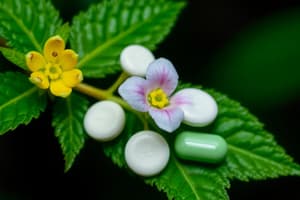Podcast
Questions and Answers
Which of the following is an animal-based drug?
Which of the following is an animal-based drug?
- Eugenol oil
- Tannin
- Heparin (correct)
- Atropine
What is a characteristic of synthetic drugs compared to natural drugs?
What is a characteristic of synthetic drugs compared to natural drugs?
- They are easier to control in terms of quality. (correct)
- They have lower safety profiles.
- They are less chemically pure.
- They are always more expensive.
Which of the following plant sources is used to obtain Atropine?
Which of the following plant sources is used to obtain Atropine?
- Digitalis Lanata
- Coffee seeds
- Belladona (correct)
- Clove
Which metallic mineral is commonly used as a haematinic?
Which metallic mineral is commonly used as a haematinic?
What type of drug is created by altering the chemical structure of a natural compound?
What type of drug is created by altering the chemical structure of a natural compound?
Which of the following is NOT a source of drugs?
Which of the following is NOT a source of drugs?
Which drug is derived from the liver?
Which drug is derived from the liver?
What is an advantage of synthetic drugs over natural drugs?
What is an advantage of synthetic drugs over natural drugs?
What is the official name of the drug commonly known as paracetamol?
What is the official name of the drug commonly known as paracetamol?
Which dosage form is defined as having a physical state that is neither solid nor fluid?
Which dosage form is defined as having a physical state that is neither solid nor fluid?
What does the term 'minimum effective concentration' (MEC) refer to in pharmacology?
What does the term 'minimum effective concentration' (MEC) refer to in pharmacology?
Which of the following terms refers to a range of plasma drug concentrations that yield the desired response without toxic effects?
Which of the following terms refers to a range of plasma drug concentrations that yield the desired response without toxic effects?
What characterizes potent drugs in terms of their dosage and therapeutic window?
What characterizes potent drugs in terms of their dosage and therapeutic window?
What type of drug form includes effervescent powders and tablets?
What type of drug form includes effervescent powders and tablets?
What is the minimum toxic concentration (MTC) of a drug?
What is the minimum toxic concentration (MTC) of a drug?
Which of the following is an example of a gaseous dosage form?
Which of the following is an example of a gaseous dosage form?
What is a key advantage of ampicillin over penicillin?
What is a key advantage of ampicillin over penicillin?
Which of the following statements about drug naming is true?
Which of the following statements about drug naming is true?
Which of the following antibiotics is derived from a bacterial source?
Which of the following antibiotics is derived from a bacterial source?
What distinguishes a brand name from a generic name?
What distinguishes a brand name from a generic name?
What role do micro-organisms play in the development of antibiotics?
What role do micro-organisms play in the development of antibiotics?
Why is the presence of an amino group in ampicillin significant?
Why is the presence of an amino group in ampicillin significant?
How is insulin produced using E. Coli?
How is insulin produced using E. Coli?
Which drug name describes the chemical structure of the drug?
Which drug name describes the chemical structure of the drug?
Flashcards are hidden until you start studying
Study Notes
Drug Sources
- Drugs have many sources, including plants, animals, minerals, synthetic, semisynthetic, and bacteria (prepared by biotechnology).
- Historically, plants were the primary source of drugs.
- Plant extracts can be used without further processing (crude drugs) or with technical processing (prepared drugs).
- Plant-based drugs can be obtained from various parts of the plant, including leaves, seeds, fruits, flowers, stems, and roots.
Examples of Drugs From Different Sources
-
Plant-based drugs:
- Digoxin is obtained from Digitalis Lanata leaf and is used to treat congestive heart failure.
- Atropine is extracted from Belladona and acts as an antispasmodic.
- Tannin from coffee seeds possesses astringent properties.
- Eugenol oil extracted from cloves serves as a local anesthetic for toothache.
-
Animal-based drugs:
- Examples include heparin (from Mexican medical leeches), insulin (from bovine pancreas), cod liver oil (from Gadus spp.), vitamin B12 extracts (from liver), and vaccines.
-
Minerals:
- Minerals have been used medicinally since ancient times.
- Both metallic and non-metallic minerals are used as drugs.
- Metallic examples: Ferrous sulfate (haematinic), Magnesium sulfate (purgative), Aluminum hydroxide (antacid).
- Non-metallic examples: Hydrogen peroxide (antiseptic), radio-isotopes of iodine (diagnostic and therapeutic agents for thyroid disorders).
-
Synthetic drugs:
- Prepared entirely in a laboratory setting.
- Examples include sulphonamide, aspirin, and paracetamol.
- Advantages over natural or semi-synthetic drugs:
- High chemical purity
- Controlled quality
- Improved safety profile (particularly regarding antigenicity)
- Cost-effective production methods.
-
Semisynthetic drugs:
- Modified versions of natural compounds.
- The basic nucleus is maintained from the natural source, with alterations to the chemical structure.
- Examples: Heroin (semisynthetic from morphine), Ampicillin (semisynthetic from penicillin).
- Ampicillin is advantageous over penicillin because the amino group in its structure makes it resistant to hydrolysis by stomach acid, allowing oral administration in contrast to penicillin's intravenous route exclusively.
Microbiota as Drug Sources
- Antibiotics were initially derived from microorganisms like penicillin.
- Examples include penicillin (from Penicillium notatum), bacitracin (from Bacillus subtilis), and insulin (produced using E. Coli via biotechnology and gene extraction).
Drug Naming
-
Each drug has three names:
-
Chemical name: Scientific name based on the chemical structure. Established when a new chemical entity (NCE) is developed. Also known as the IUPAC (International Union of Pure and Applied Chemistry) name. Example: 2-Acetoxybenzoic acid (Aspirin).
-
Generic name: International Nonproprietary Name (INN). Given during early drug investigation. Assigned by an official body, the United States Adopted Names (USAN) Council. Also known as the official name, later registered in pharmacopeia. Example: Acetyl salicylic acid (Aspirin).
-
Brand name (trade name): Developed by the company seeking approval for the drug. Often easier to remember than the generic name. Both the brand and generic names must be approved by regulatory bodies like the FDA. Both names ensure the drug's safety and effectiveness. Each drug has one generic name but can have multiple brand names. Example: Acetylsalicylic acid (generic) is available under various brand names like Aspirin®, Aspocid®, Juspirin®, Aggrex®, and Aspirin®protect 100.
-
-
Sometimes, the brand name of a specific pharmaceutical company may be different in other countries due to cultural factors.
Types of Dosage Forms
- Dosage form: The physical form of a medication and how it releases the drug and delivers it to the body.
- Dosage forms are classified according to their physical state:
- Gaseous: Inhalation anesthetics and aerosols.
- Liquid: Solutions, emulsions, and suspensions.
- Solid: Effervescent powders, granules, tablets, and capsules.
- Semisolid: Creams, ointments, gels, and pastes.
Drug Dosage and Therapeutic Window
-
Therapeutic window: The range of drug concentrations within which the desired effect is achieved without causing toxicity.
-
Minimum Effective Concentration (MEC): The minimum drug concentration necessary to achieve a pharmacological effect.
-
Minimum Toxic Concentration (MTC): The minimum concentration at which dose-related toxic side effects occur.
-
Potent drugs have a narrow therapeutic window (small difference between MEC and MTC), meaning small increases in concentration can lead to toxicity. Drug dosages are often measured in micrograms (µg) to milligrams (mg).
-
Digoxin is an example of a potent drug with a therapeutic window ranging from 0.0006 to 0.0013 mg/liter. Its daily dose is typically 0.25 mg (250 µg).
Studying That Suits You
Use AI to generate personalized quizzes and flashcards to suit your learning preferences.





